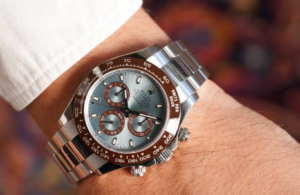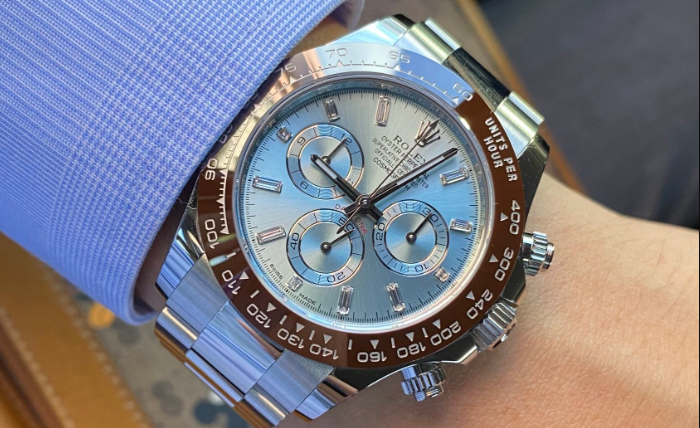Any collector knows that when Rolex introduces a new version of one of its most iconic designs, modernizes it with a plethora of never-before-seen features, and then keeps the production run relatively short, the watch will become a hit on the pre-owned market. Rolex has many such models, but the Fat Lady herself, the original Rolex GMT-Master II ref. 16760, remains one of the more enduring must-haves.
Perhaps the most recognizable watch to the eye in the entire catalog, the two-tone bezels on the various Rolex GMT Master models ensured that they were never mistaken for submarines, even though the two collections were always similar in style and were released around the same time in the mid-1950s.
Developed in conjunction with Pan Am as a way for their pilots to track different time zones on transatlantic flights, the GMT Master quickly became a favorite among military pilots and was even worn on the wrists of NASA astronauts – Jack “Houston, we’ve got a problem” Swigert wore it on the ill-fated Apollo 13 mission. More recently, watch collector John Mayer was spotted wearing a GMT with a Pepsi bezel on his wrist, as was James Bond actor Daniel Craig. The Rolex GMT Master has also earned an enthusiastic following from high-mileage business travelers who find that setting local and home time zones on their tag heuer replica watches counteracts some of the mental stress of jet lag.
Rolex introduced the GMT-Master in the 1950s as the 6542. The early versions featured the ill-fated bakelite bezel, which was soon replaced by aluminum due to its tendency to crack. Aluminum remained the preferred bezel material until 2000, when Rolex’s patented “Cerachrom” ceramic material replaced it.
This was followed by the 1675, 16750, and 16700 models. However, there was some overlap between the original GMT-Master and GMT-Master II, with the Ref. 16750 (1981 – 1988) continuing production alongside the GMT-Master II “Fat Lady” model. 16760 (1982 – 1988). In addition, Ref. 16700 GMT-Master, introduced after the “Fat Lady” was discontinued, remained a fixture in the Rolex catalog until 1999, with a significant overlap with the GMT-Master II. As a result, the Ref. 16700 received many upgrades that its predecessors did not, such as a sapphire crystal and improved luminescent materials. 16700 was the last watch in the GMT-Master series.
Due to the popularity of the watch, the original GMT-Master was produced until 1999. Of course, it went through a series of major updates during its nearly 45-year lifespan, but even its supposed replacement, the first GMT-Master II series, introduced in 1982, could not stop it from taking wing.
The elegant curves and generous proportions of this original 16760 watch, also known as the “Sophia Loren”, are the necessary design features to house the new caliber 3085 movement.
The case is thicker, but it maintains the standard 40 mm size and 100 m depth rating. It also features a three-link Oyster bracelet or a five-link Jubilee bracelet, and a luminescent material of tritium on the dial – a standard for Rolex watches of the 1980s.
Although the ability to quickly set the date had to be sacrificed, the new movement is a logical addition to the Ultimate Traveler best swiss replica watches, as it finally allows the hour hand to be decoupled from the GMT hand. This means that setting a second-time zone at your destination is now instantaneous, with the local 12-hour hand able to jump backward or forwards independently of the arrow-tilted 24-hour hand. Thus, it is even possible to track a third-time zone by reading the position of the 24-hour hand in relation to the striking rotating bezel.
The various two-color schemes have always been one of the main selling points of the GMT. When the first Cerachrom version was released in 2005 with an all-black bezel, Rolex insisted that it was impossible to add a second color to their new patented ceramic, and the GMT faithful were clearly not impressed. (The “impossible” blue and black Cerachrom Batman version was released shortly thereafter).
In addition to being aesthetically appealing and setting the watch apart from other sporty watches in the collection, the contrasting colors on the bezel played an important role in helping jet-lagged wearers distinguish night from day when traveling between time zones. The original 1950s version quickly gained the ‘Pepsi’ label for its blue and red bezel, blue for day and red for night. It was later joined by the brown and gold ‘Root Beer’ (known in some circles as Clint Eastwood).
As of this writing, the Rolex 16760 is trading for about $14,000 on the used market. Not a bad entry price for a vintage GMT-Master II with so much history. For comparison, the ceramic-bezel GMT-Master II ref. 116710 is also reselling for around $14,000, while its predecessor, ref. 16710 will set you back anywhere from $12,000 to $15,000, depending on the condition of the watch and its specific features.
Even so, the Rolex GMT-Master II 16760 is a bargain on the pre-owned market for a model with so much pedigree. While finding an example in good condition can take some searching, those new to the world of vintage watches are often pleasantly surprised by their availability, and for many watch enthusiasts, this marks the beginning of their Rolex collecting journey.
